Decoding Crypto's Future: Monolithic vs Modular Blockchains
In 1913, Henry Ford introduced assembly lines as a novel industrial design. It revolutionized how we manufactured goods, shifting from the era where a single worker would craft a product from start to finish to a more efficient, specialized system where each worker contributed a specific piece of the puzzle. This change enabled the worker to become exceptionally skilled at a very specific task, accelerating production rates and enhancing the quality of the products.

A shift from a Monolithic blockchain design, underpinned by Bitcoin and Ethereum, to a modular design like in Polkadot or Celestia represents a similar strategic advancement. Much like pre-assembly line industries, monolithic blockchain nodes handle all blockchain infrastructural tasks like block validation and consensus, while a modular design offloads these tasks across multiple specialized layers of blockchain networks. The division of labour, where the blockchain dissects into multiple segments, allows greater flexibility and scalability.
In this article exploring monolithic vs modular blockchains, I will discuss the different flavours of blockchain modularity and contrast them with the monolithic approach. We will explore the benefits and trade-offs of each design and learn why the cryptosphere is becoming increasingly modular.
Understanding Blockchain Architecture
In this section, we will look into the architectural layers of a typical blockchain network. I will build on several foundational concepts of blockchain technology, so a basic conceptual understanding is paramount for the readers. I sincerely recommend that readers check out the “Beginners Guide to Blockchain Technology” on the Coin Bureau, which will refresh your basic concepts and help you enter the right headspace to absorb the concepts we are about to explore.
Blockchain is a decentralized, distributed ledger that records transactions across multiple computers (nodes) in a way that ensures security, transparency, and immutability. It employs cryptographic hashing and consensus mechanisms, such as Proof of Work or Proof of Stake, to maintain data integrity and prevent unauthorized alterations. Each record, or “block,” is linked to previous ones, forming a chain, thereby making the history of all transactions permanently visible and verifiable by all participants.
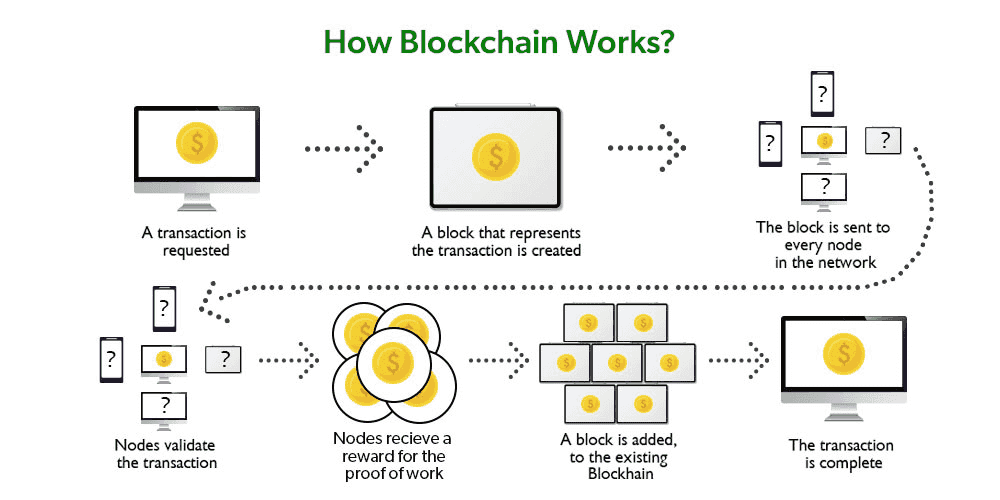
What are Blockchain Layers?
To deepen our understanding of how blockchains operate, let’s return to the earlier analogy of an assembly line. In an assembly line, where different tasks are compartmentalized to increase efficiency, a blockchain consists of various “layers” — though, in practice, these layers are more of a conceptual framework designed to separate and clarify the roles within the blockchain's operation.
Blockchain is essentially software running on various nodes that collectively maintain a replicated, real-time state. Each node in the network continuously updates and verifies the ledger's state, ensuring all transactions are recorded correctly and securely.
Conceptualizing Layers
In reality, a blockchain does not have physical layers; instead, these layers are a conceptual construct used to segment the blockchain into different process areas. This helps in understanding the specific functions and interactions happening at each point during the lifecycle of a block:
- Data Availability Layer: Also referred to as the Networking layer, it ensures all data regarding transactions is accessible to nodes.
- Consensus Layer: Nodes agree on the current state of the blockchain and validate transactions.
- Settlement Layer: Confirmed transactions are irreversibly recorded on the blockchain.
- Execution Layer: Also known as the Application layer, it handles the execution of transactions according to the rules of the protocol, particularly for smart contracts.
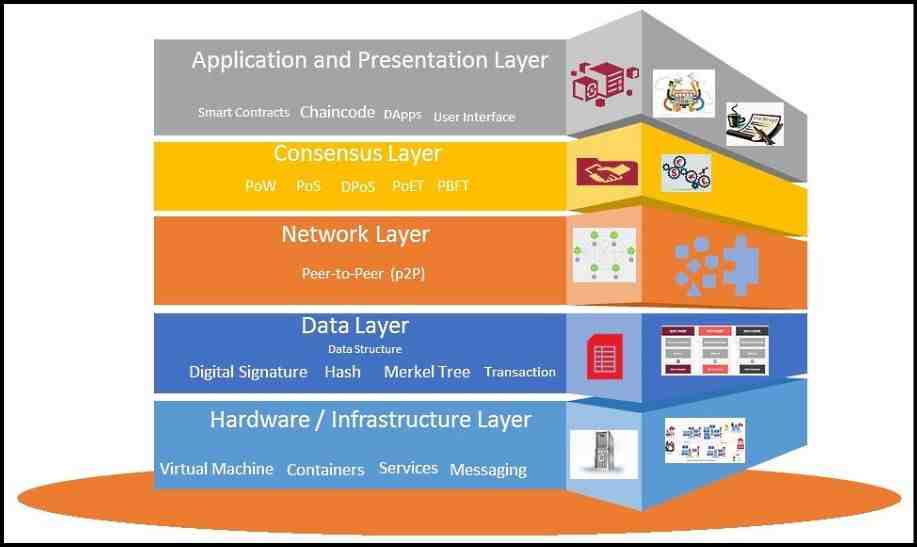
A blockchain is a complex integration of processes and interactions within and between nodes in the network. By conceptualizing these processes as separate layers, we can better understand and appreciate the intricate workings of each step in the life of a block. This structure not only helps in analyzing how blockchains function but also aids in troubleshooting and optimizing each layer for better performance and scalability.
In the following sections, we will explore each functional layer in detail, starting with how a block is formed and progressing through the operational specifics of each layer.
How Do These Layers Interact?
In the context of a PoS blockchain like Ethereum, the processes of data availability, consensus, settlement, and execution are tightly integrated into its single-layer structure, meaning the same network of nodes performs all these tasks. Here’s a detailed breakdown of how these processes work:
1. Data Availability
- Data Receiving and Broadcasting: Each node receives new transaction data from users and other nodes. This data is essential for checking the transaction’s validity (e.g., whether the transaction’s digital signature is valid and the nonce matches the expected value) and is then broadcast to other nodes.
- Data Storing: After validating transactions, the node stores this data in its local version of the transaction pool and prepares it for inclusion in a new block.
2. Consensus
- Block Proposal: In Ethereum PoS, a node may be randomly selected to propose a block based on its stake. The chosen validator collects transactions from its transaction pool, forms a block, and proposes it to the network.
- Block Validation: If the node is not selected as the leader, it participates in the consensus process by attesting to blocks proposed by other nodes. This involves checking proposed blocks against the node’s local state and consensus rules and then voting on the block’s validity.
3. Settlement
- Transaction Execution: When a block is accepted by the consensus process, the node executes all transactions in the block sequentially. This execution involves changing the state stored in the node’s version of the Ethereum blockchain (such as balances and contract states).
- State Finalization: Post execution, the new state is finalized; this means that the results of the block are officially part of the Ethereum ledger and recognized as immutable under normal operation.
4. Execution
- Smart Contracts and Transactions: Execution on Ethereum involves processing standard transactions and smart contracts. This is done using the Ethereum Virtual Machine (EVM), which every node runs locally. Each transaction can potentially change the state on the blockchain depending on its logic.
This process illustrates the integrated nature of traditional blockchains like Ethereum. They contrast with more modular approaches where different layers or components might be separated across different nodes or infrastructures (like rollups or separate data availability networks), but we will get to that shortly. This integrated approach ensures high security and data consistency but can pose scalability challenges, which Ethereum seeks to address with upgrades like sharding. For now, let’s use the interaction defined above as a backdrop to understand these layers:
Data Availability
Data Availability (DA) refers to a blockchain's ability to ensure that all necessary data (e.g., transactions, states, signatures) is accessible to all participants who need it to validate and execute transactions. This is crucial for maintaining transparency and security in decentralized networks.
Example: In Ethereum, all transaction data must be available to all nodes; this is why each transaction is broadcast across the network. In a more specialized context, Celestia provides a general-purpose data availability layer for other blockchain networks, allowing them to operate independently of data storage and broadcast constraints. The nodes securing the DA layer render two essential capabilities to the network:
- Liveness Guarantees: Ensuring the chain keeps propagating. A liveness failure is a situation where not enough voting power is participating in consensus to ensure BFT tolerance (typically 1/3rd). DA ensures a sufficient threshold number of nodes have enough data to participate in the network consensus and validate transactions.
- Invalid Transactions Get Rejected: DA ensures nodes have sufficient data to check if a transaction is invalid and gets rejected.
Note: An invalid transaction is different from a rejected transaction. Transactions that pay enough gas might be included in a block, but inclusion does not guarantee execution. Validators perform checks such as signature verification and balance checks once a transaction is included. If a transaction fails these checks, it is considered invalid but still consumes gas for the checks performed. Therefore, a transaction may be accepted into a block but can still be invalidated if it fails to meet the necessary criteria.
Consensus
The consensus layer is responsible for agreeing on the order and validity of transactions in a decentralized manner, ensuring all participants have a consistent view of the ledger. Example: Bitcoin uses a Proof of Work (PoW) mechanism where miners solve computational puzzles to propose new blocks. Ethereum 2.0 adopted a Proof of Stake (PoS) approach, where validators stake crypto assets for the right to validate transactions and propose blocks.
The nodes participating in consensus render protection against chain reorganization events. Let’s break it down:
Chain Reorganization Events
Chain reorganization (often referred to as "reorg") events in blockchain technology occur when a blockchain network discards blocks from its current longest valid chain and replaces them with a different set of blocks. This can happen for a few reasons, most commonly due to the network nodes receiving blocks at different times due to transmission delays, which leads to temporary discrepancies in the blockchain's ledger.
How Consensus Layers Protect Against Reorgs
- Establishing Consensus Rules: The consensus protocol generally follows the “longest chain rule”, where the valid chain is the one with the greatest number of blocks.
- Finality Mechanisms: Many PoS systems have finality checkpoints, which once met, the blocks and their history cannot be reverted without an extremely large coordinated effort (like 2/3 of validators colluding). In Ethereum, finality checkpoints are called epochs. Each epoch comprises 32 slots and each slot may or may not include a block.
- Network Latency Management: Efficient data propagation methods ensure that blocks are transmitted quickly and evenly across the network, reducing the chances of simultaneous block creation and accidental forks that lead to reorgs.
Settlement
Settlement in blockchain refers to the process by which transactions or contracts are concluded and considered irreversible. This involves calculating the blockchain's state with the results of accepted transactions.
Example: On the Bitcoin network, settlement occurs when a transaction is included in a block and that block becomes part of the longest blockchain fork. In Ethereum, the transition from pending transactions to a confirmed (settled) state happens after transactions are successfully included in a block and acknowledged by the network.
Execution
The execution layer processes all operations specified in transactions and smart contracts. This layer computes the outcomes and updates the blockchain state accordingly. Generally, execution is done locally by every node after DA, consensus and settlement. Therefore, each node executes the same processes in the same order and arrives at the same result as every other node.
Example: The Ethereum Virtual Machine (EVM) is the execution engine for Ethereum, interpreting and executing smart contract bytecode stored on the blockchain. This allows for implementing complex decentralized applications like Uniswap for decentralized trading or Compound for decentralized lending, where contract logic is executed uniformly across all nodes.
What are Monolithic Blockchains?
Monolithic blockchains represent the original architecture of blockchain technology, where all critical functions — data availability, consensus, settlement, and execution — are integrated into a single layer. In this architecture, the same nodes handle every aspect of the blockchain process.
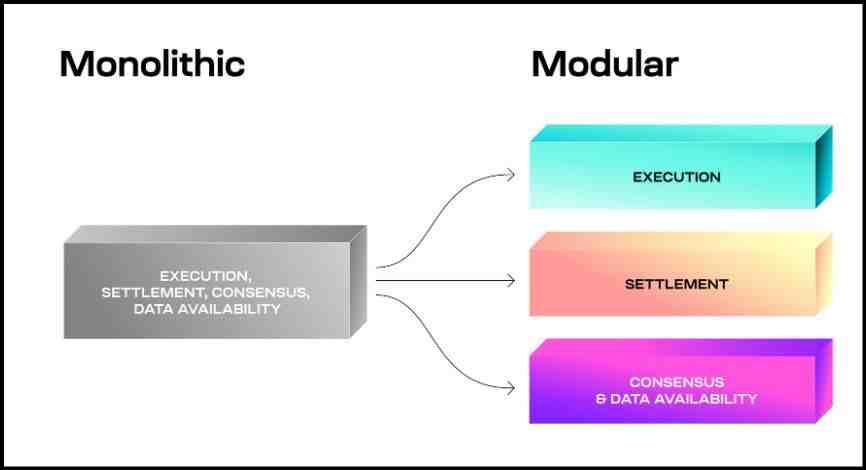
Core Characteristics
- Integrated Operations: In monolithic blockchains, all key operations are performed by all nodes concurrently. This means that each node in the network must be able to store data, validate transactions, finalize settlements, and execute contractual agreements.
- Hardware and Network Requirements:
- Data Availability: Nodes require significant storage capacity to maintain a complete history of the blockchain's data.
- Consensus: Efficient consensus mechanisms depend on a reliable and low-latency network connection and a substantial stake in the network to incentivize honesty and participation.
- Settlement: Processing power is critical as nodes must be able to process transactions to maintain the network’s throughput quickly.
- Execution: A stable and continuous connection is necessary to ensure that end-users can access and interact with the blockchain data without disruptions.
Scalability Challenges
As the number of users and transactions on a monolithic blockchain grows, each node's processing power, memory, and network bandwidth requirements increase linearly. This scalability challenge is significant because every node must scale its capabilities to handle the greater demands of the network.
Examples and Evolution
- Classic Examples: Bitcoin, Ethereum (before its 2.0 upgrade), and Solana are prime examples where all nodes handle all network operations uniformly.
- Transitional Architecture: Ethereum is currently transitioning to a more modular architecture with Ethereum 2.0, which incorporates elements like sharding and rollups to distribute the execution load to specialized layer 2 networks. This shift is aimed at overcoming the inherent scalability issues of monolithic designs by decoupling the execution layer from the main consensus tasks.
Conclusion
While foundational to the blockchain ecosystem, monolithic blockchains face growing pains as they scale with increased adoption. The single-layered approach simplifies the node design and operations but at the cost of requiring highly capable and, thus, more costly infrastructure. This architecture's simplicity and robustness are ideal for smaller or less complex networks but might struggle under the weight of a burgeoning blockchain ecosystem.
In the next section, we will explore modular blockchains, which offer a promising solution to traditional monolithic designs' scalability and efficiency challenges by separating various blockchain functions into distinct layers.
What are Modular Blockchains?
Modular blockchains represent a significant evolution in blockchain architecture designed to address the inherent limitations faced by monolithic systems. As blockchain technology matures and diversifies with Web3 applications, the need for more scalable, customizable, and efficient networks becomes paramount.
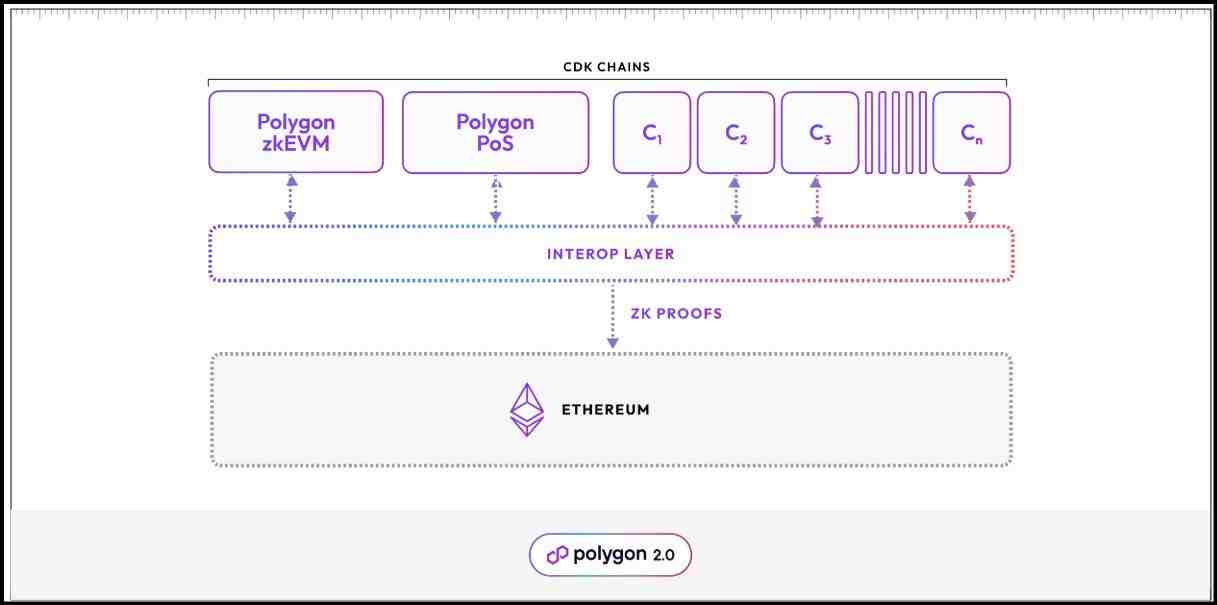
Core Characteristics
- Evolutionary Design: Unlike monolithic blockchains that consolidate all processes within a single layer, modular blockchains separate these processes into distinct layers or modules. This segregation allows each module to specialize and optimize for its specific function, whether it be data availability (DA), consensus, settlement, or execution.
- Specialization for Efficiency:
- Scalability: By distributing the workload across multiple specialized networks, modular blockchains can handle more transactions and interactions than traditional monolithic blockchains. This setup reduces the load on any single network, significantly enhancing scalability.
- Programmability and Customizability: Each layer can be independently developed and updated without impacting other areas of the blockchain, allowing for greater flexibility and rapid implementation of innovations.
Operational Dynamics
- Block Formation Cycle: In modular blockchains, the block formation process involves multiple networks where each performs a part of the total task required to produce a block. These networks share relevant information seamlessly to ensure integrity and continuity.
- Example of Layer Interaction: The most illustrative example of modular architecture in action is the Layer 2 ecosystem on Ethereum, including networks such as Arbitrum, Optimism, and Polygon zkEVM. These platforms primarily handle execution tasks while relying on the Ethereum main chain for data availability, consensus, and settlement.
Broadening the Scope
- Beyond Layer 2s: While Layer 2 networks are prominent examples, the modular concept extends to various designs, each with its own set of advantages and considerations. This includes standalone sidechains, validium, and hybrid systems that mix different elements of modularity to suit specific needs.
Conclusion
The transition to modular blockchains is akin to the evolution from single-factory production lines to complex, interconnected industrial parks where each facility specializes in a particular aspect of the production process. This approach improves overall efficiency and offers the flexibility needed to adapt to future challenges and opportunities in the blockchain sector.
In the subsequent sections, we will explore the different types of modular designs, their unique benefits, and the trade-offs they might have.
Modular Blockchain Designs
The concept of modularity in blockchain has been catapulted into the limelight primarily due to the scalability solutions provided by Ethereum's Layer 2 technologies. However, the potential of blockchain modularity extends far beyond just improving transaction capacity. By thinking of these technologies as configurable "legos," developers can assemble networks with tailored functionalities and distinct capabilities. Below are some key examples of how modularity is being implemented:
Execution Rollups
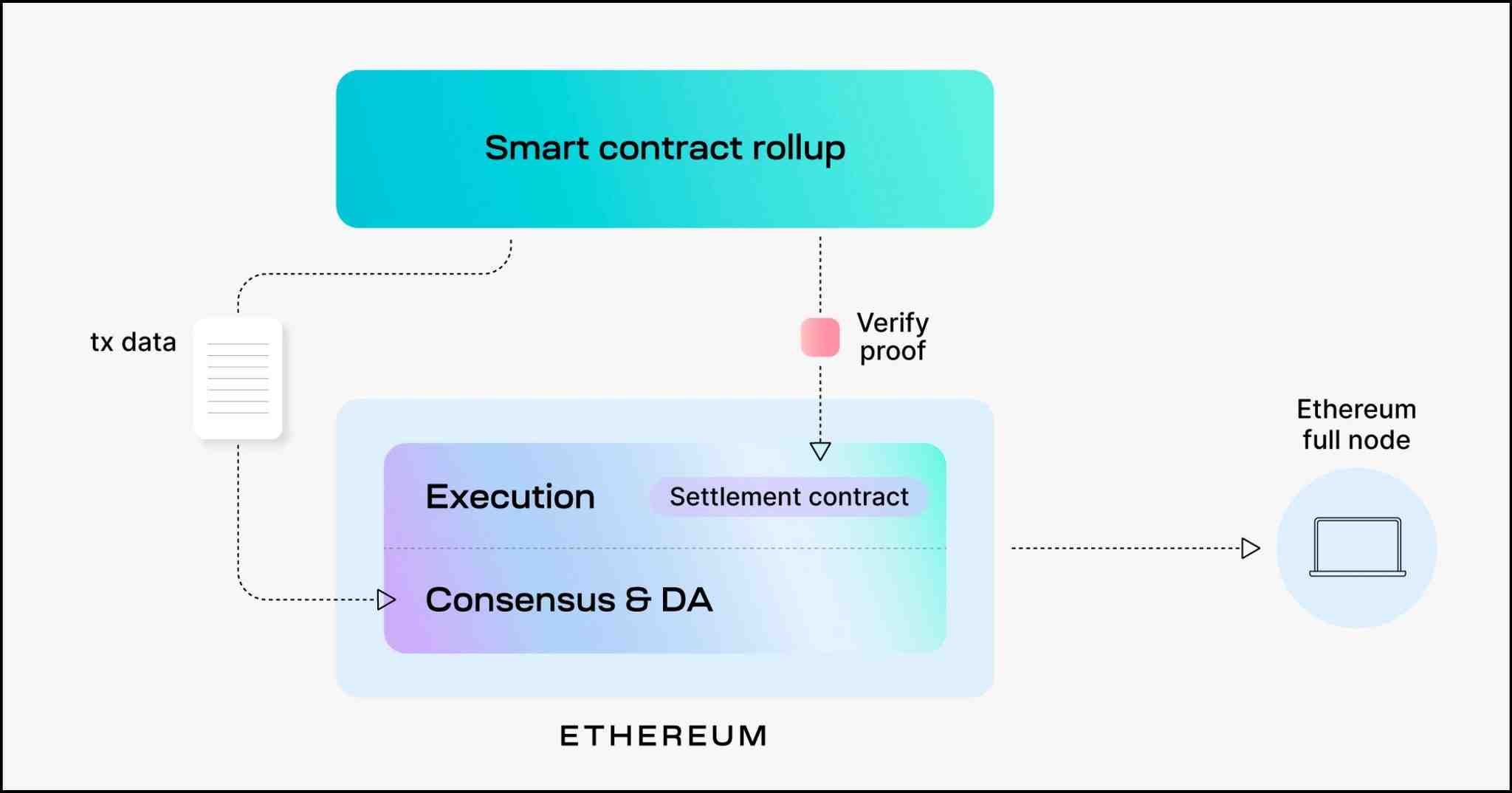
Execution rollups (sometimes called smart contract rollups) are currently the most prominent design in the modular blockchain space, especially within the Ethereum ecosystem. Notable projects in this category include Optimism, Polygon zkEVM, Arbitrum, and Starknet, among others.
How It Works
- Process: In an execution rollup, the execution layer operates as a distinct network that processes transactions independently but relies on a parent network (such as Ethereum) for data availability, consensus, and settlement functions. The execution layer can be a simple light node with no need to stake or have consensus; all that is taken care of in the Ethereum layer.
- Mechanism: A rollup sequencer node collects a large number of transactions, executes them, and then bundles the transaction data into a compact rollup block or "bundle." This bundle is submitted to the main Ethereum blockchain through a specific rollup smart contract, accompanied by validity proofs (to verify the correctness of transactions), typically zero-knowledge validity proofs.
- Integration with Ethereum: Once submitted, the entire Ethereum network becomes responsible for:
- Data Availability: Storing and disseminating the transaction data contained in the rollup bundles.
- Settlement: Utilizing the provided transaction data and validity proofs to verify and finalize transactions.
- Consensus: Incorporating the updated rollup state into the Ethereum blocks as part of the global Ethereum state.
Advantages
- Scalability: By processing multiple transactions off-chain and only settling final states on-chain, rollups can significantly increase throughput.
- Cost Efficiency: Distributing the Ethereum gas costs across numerous transactions within a single rollup bundle reduces the average transaction fee.
- Security and Reliability: Rollups benefit from Ethereum's underlying security and consensus mechanisms, ensuring robust protection against double-spending, network forks, and liveness failures.
- Interoperability: Given that they share the Ethereum ledger for settlement, rollups inherently support interactions with other Ethereum-based applications and rollup chains. Therefore, the Ethereum layer can bridge cross-chain transactions and smart contract calls between other Ethereum rollups. However, rollups typically use external bridges to avoid the high gas costs of Ethereum.
Disadvantages
- Limited Sovereignty: Rollups are constrained by the capabilities and rules of the Ethereum network and the Ethereum Virtual Machine (EVM). They cannot execute transactions incompatible with EVM logic or undergo protocol upgrades independently of Ethereum’s consensus process.
Validium
Validium is an innovative Layer 2 scaling solution that prioritizes high scalability by strategically trading off some of the security guarantees typically provided by its parent chain. A key example of Validium architecture in action is the transition of Polygon's PoS chain under the upcoming Polygon 2.0 upgrade, evolving from an Ethereum sidechain to a fully-fledged Validium system.
How Validium Works
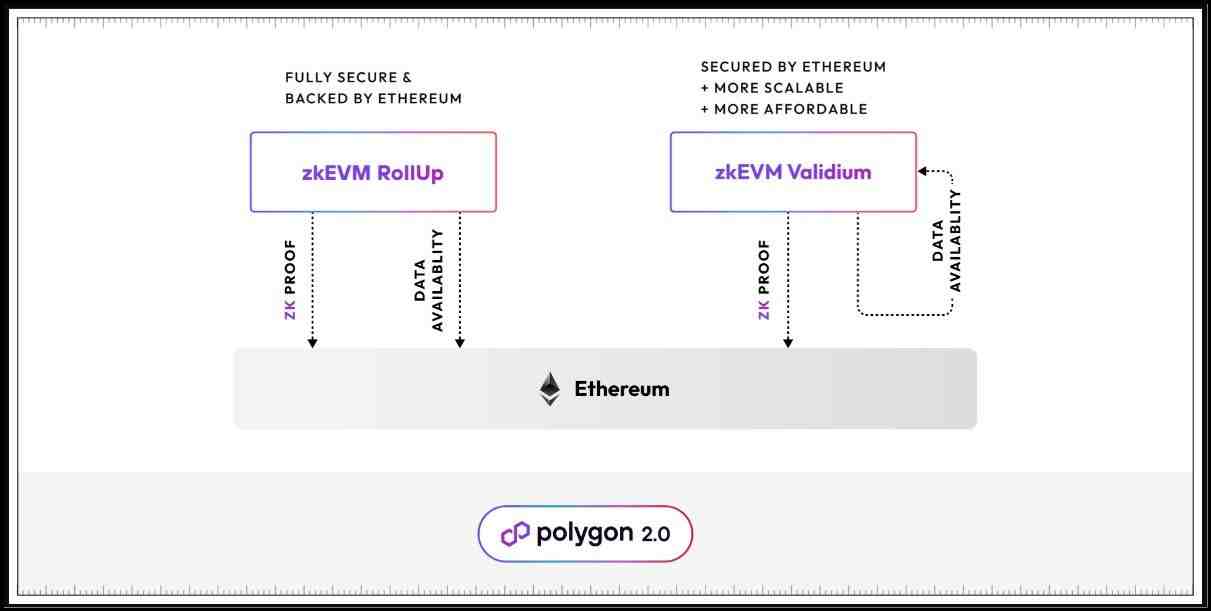
To fully grasp how Validium operates, it is useful to compare it with execution rollups:
- Execution Rollups: These systems depend on the Ethereum network for data availability (DA), consensus, and settlement. Among these functions, DA is often the most resource-intensive, as it involves comprehensive transaction data and state transitions, requiring significant storage space on Ethereum.
- Validium Shift: In contrast, a Validium configuration modifies this by outsourcing (or self-managing) its DA needs. This means that while it still relies on Ethereum for consensus and settlement, it arranges its own DA, typically through external or proprietary systems.
Operational Details
- Data Handling: In a Validium system, a “DA attestation” is provided instead of uploading full transactional data to Ethereum. This attestation serves as proof that the data is available to the Validium nodes but not necessarily stored on the Ethereum blockchain.
- Security and Integrity: While the responsibility for keeping data available and secure in real-time shifts to the Validium nodes, Ethereum continues to handle the finality and validation of transactions using validity proofs. This setup ensures that Ethereum can still verify the integrity of transactions without directly handling all the data.
- Case Study - Polygon zkEVM Validium: Under the planned Polygon 2.0 architecture, the Polygon network will use its own PoS mechanism powered by the POL token to manage data availability, ensuring liveness and integrity, showcasing a tailored approach to Validium's DA challenges.
Advantages of Validium
- Enhanced Throughput: By reducing the data load on the parent blockchain, a Validiu rollup can pack significantly more number of transactions in every bundle. Therefore, Validium can process a significantly higher volume of transactions, boosting overall network throughput.
- Cost Efficiency: With fewer data commitments on Ethereum, the associated gas fees are considerably lower, making transactions more economical for users.
Disadvantages of Validium
- Reduced Security Guarantees: Unlike full execution rollups, Validium does not leverage the complete cryptographic and economic security mechanisms of the Ethereum network. This can potentially expose it to higher risks of data unavailability or manipulation (like including invalid transactions in the block) if the external DA systems are compromised.
Sovereign Rollups
Coined by Celestia, a modular general-purpose DA provider, the term "Sovereign rollups" refers to a type of rollup architecture that maintains sovereignty. This means it does not require its parent chain’s permission to alter fundamental rules, such as the execution environment or programming language, offering a higher degree of independence and customization compared to other rollup types.
What Sets Sovereign Rollups Apart?
To understand why Execution rollups and Validium are not considered sovereign, we need to delve into the concept of settlement within these systems:
- Settlement Overview: In the context of rollups, settlement involves verifying transaction validity using DA data (or its attestation) and validity proofs to ensure transactions are correctly executed.
- Execution Environment Dependency: For a parent chain like Ethereum to provide settlement services to a Layer 2 system, it must be able to understand and verify the transactions executed on Layer 2. This typically requires Layer 2 to use the same execution environment as the parent chain (e.g., the Ethereum Virtual Machine or EVM).
How Sovereign Rollups Work
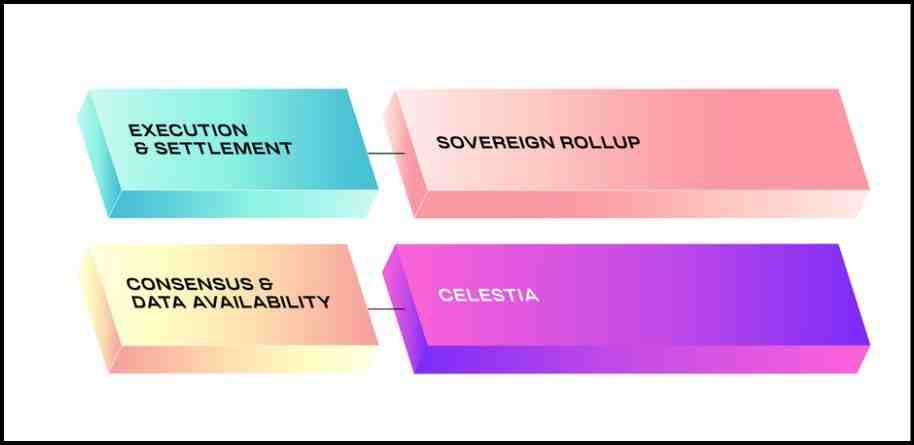
- Modular Design: A Sovereign rollup has separate settlement and execution layers, with the parent chain providing only DA services and consensus.
- Execution Flexibility: Unlike traditional rollups, sovereign rollups are not bound to use the same execution logic as the parent chain. This allows them to implement different virtual machines or execution environments independent of the parent chain's infrastructure.
- Settlement Autonomy: Sovereign rollups handle their own settlement processes internally or through third-party networks. This autonomy enables them to operate independently of the parent chain’s execution logic.
Technical Mechanism
- DA and Consensus: The parent chain’s role is limited to ensuring data availability and participating in consensus mechanisms, which do not require understanding the specific data or transactions of the sovereign rollup.
- Operational Example: If a Sovereign rollup on Ethereum switched from using the EVM to adopting Solana’s environment, for instance, it could do so without Ethereum's nodes having to approve or even understand the change.
Advantages of Sovereign Rollups
- Flexibility and Customization: Sovereign rollups can independently change their execution standards and upgrade their systems without needing approval from the parent chain.
- Foundation for Appchains: This rollup type is ideal for application-specific blockchains (appchains) requiring tailored execution environments to optimize performance and functionality.
Disadvantages of Sovereign Rollups
- Security Concerns: The decentralization and independence of sovereign rollups might also be a drawback. Because they do not leverage the full security mechanisms of the parent chain, they may be more susceptible to attacks, especially if the Layer 2 network does not have a robust and well-incentivized validator base.
- Economic Risks: There is a potentially lower economic disincentive for malicious actors within the network, as the economic stakes involved in Layer 2 might not be as significant as those in established Layer 1 networks like Ethereum.
Modular Blockchain Designs - Conclusion
The exploration of modularity designs such as Execution rollups, Validium, and Sovereign rollups demonstrates the innovative ways in which blockchain architecture is evolving to meet diverse needs. Each design offers unique benefits and trade-offs, highlighting the potential for tailored blockchain solutions that optimize scalability, autonomy, and efficiency across various applications and platforms. The following diagram sums up the various designs we explore today.
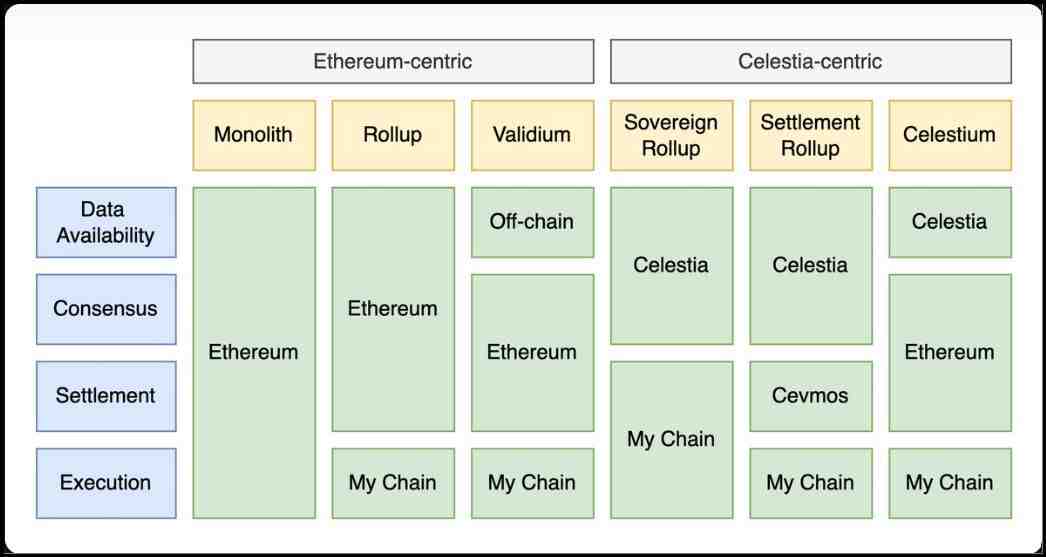
Monolithic vs. Modular Blockchains Compared
The following table summarizes the architectural and operational differences between monolithic and modular blockchains.
Feature | Monolithic Blockchains | Modular Blockchains |
|---|---|---|
| Architecture Type | Integrated single-layer architecture | Multi-layered architecture with distinct separation of responsibilities |
| Core Characteristics | Uniform functionality across the network, simpler design | High customization, flexibility in design and function |
| Node Requirements | High computational power and storage needed by all nodes | Different layers can have varying requirements, generally lower per node |
| Scalability | Scalability limited by the capability of individual nodes | Enhanced scalability due to task specialization and load distribution |
| Consensus Mechanism | One consensus mechanism for all operations | Different layers can use different mechanisms for efficiency |
| Data Availability | All nodes must store complete data | Data storage can be isolated to specific layers, reducing load on other nodes |
| Execution Process | All nodes perform transaction execution | Execution can be delegated to specialized layers |
| Settlement Process | Settlement integrated into overall node operations | Settlement can be handled by a dedicated layer, improving speed and efficiency |
| Security | Consistent security protocols across all nodes | Layer-specific security protocols can optimize threat responses |
| Cost Efficiency | Higher operational costs due to uniform node requirements | Potential for lower costs through layer optimization |
| Development Flexibility | Limited flexibility, updates affect the entire network | Higher flexibility, individual layers can be updated independently |
| Examples | Bitcoin, Ethereum (pre-2.0) | Ethereum 2.0, Polkadot, Celestia, Avalanche |
| Interoperability | Generally limited to interactions within the same blockchain | Higher potential for interoperability across different blockchain systems |
| Adoption Challenges | High resource demands on nodes, scalability issues | Complexity in design and integration, potential for higher initial setup costs |
Parting Thoughts – Web3 Getting Increasingly Modular?
As we conclude this exploration into the evolving architectures of blockchain technology, a key question emerges: Why is Web3 increasingly adopting modular designs? The shift towards modularity in blockchain is not merely a trend but a response to several critical challenges and opportunities in the digital landscape.
Capacity and Scalability Limits
The widespread adoption of blockchain technology has exposed the limitations of monolithic architectures. These systems, while foundational, struggle to scale efficiently as they require every node to process every transaction. Modular blockchains, by contrast, allow for scaling without compromising on decentralization by distributing tasks across specialized layers or nodes, thereby enhancing performance and capability.
Diverse Web3 Functionalities
The scope of Web3 is rapidly expanding to include a variety of functions, such as Real-World Assets (RWAs), Decentralized Physical Infrastructure Networks (DePIN), and advanced privacy solutions. A one-size-fits-all approach typical of monolithic blockchains is increasingly inadequate for handling this diversity. Modular systems provide the flexibility needed to tailor specific layers or modules to meet these varied requirements efficiently and effectively.
Efficiency in Transaction Processing
In an ecosystem where low-risk and high-risk transactions coexist, modular blockchains offer an efficient solution by segregating these transactions based on their security needs. This optimizes gas costs and ensures that high-risk transactions get the robust security focus they require without burdening simpler transactions with unnecessary costs and processing delays.
Popularity of General-Purpose Solutions
Platforms like Celestia, EigenDA, Polkadot, and Cosmos demonstrate the growing preference in the blockchain community for general-purpose, modular solutions. These platforms facilitate a more tailored development and maintenance environment, allowing developers to innovate with greater freedom and specificity.
Ethereum's Evolving Role
Perhaps one of the most significant indicators of this shift is Ethereum’s maturation into a primarily Data Availability (DA) layer within Web3. The ecosystem can achieve higher throughput and scalability by reallocating responsibilities traditionally handled by Ethereum to specialized layers or rollup chains. This transformation underscores the broader movement towards a more decentralized and efficient framework where Ethereum supports a foundational role but not an all-encompassing one.
Final Thoughts
The move towards modular blockchains reflects a natural evolution of the technology as it matures and diversifies. Just as the internet grew from a monolithic infrastructure to a complex, multi-layered ecosystem, blockchain technology is similarly diversifying to meet the demands of an increasingly complex digital world. Modular architectures promise a more scalable, flexible, and efficient blockchain infrastructure, making them a cornerstone for the future development of Web3 technologies. In embracing modularity, the Web3 community is paving the way for a more robust, decentralized, and innovative digital future.
Frequently Asked Questions
Monolithic blockchains are traditional blockchain architectures in which every node within a single layer manages all network functions—such as transaction processing, data storage, consensus, and execution. This integrated approach ensures uniformity and simplicity but can limit scalability and flexibility. Examples include Bitcoin and Ethereum (pre-2.0 upgrade). Monolithic designs are often praised for their robust security and straightforward operational model.
Modular blockchains separate the various functions of a blockchain into different layers or components, each specialized for a specific task such as consensus, execution, or data storage. This architecture allows each layer to operate independently and be optimized according to its specific needs, enhancing scalability and efficiency. Modular blockchains are increasingly popular as they offer the flexibility to adapt to diverse requirements and scale more effectively than monolithic systems.
Blockchain modularity can manifest in several forms, each catering to different operational efficiencies and needs:
- Execution Rollups: These are modular systems where the execution layer operates independently but leverages a parent blockchain like Ethereum for data availability, consensus, and settlement. This type helps in handling more transactions off the main chain to increase scalability.
- Validium: Similar to execution rollups, Validium segments out the data availability to an external system while utilizing the parent chain for consensus and settlement. This design increases transaction throughput by reducing the data burden on the main blockchain.
- Sovereign Rollups: These allow for greater autonomy by enabling the rollup to operate with its own settlement and execution rules independently of the parent chain's protocols. Sovereign rollups use the parent chain primarily for data availability and consensus, providing the flexibility to innovate or upgrade without needing parent chain approval.
Modular systems are not inherently less secure but have different security considerations compared to monolithic systems. By distributing tasks across multiple layers or nodes, modular blockchains can isolate risks and enhance security through specialization. However, the interfaces between modules can introduce vulnerabilities if not properly secured. Overall, the security of a modular system largely depends on the design and implementation of its interconnecting layers.
Some of the leading projects in blockchain modularity include:
- Ethereum 2.0: Introducing danksharding and rollup-centric roadmap to improve scalability.
- Polkadot: Uses a central relay chain and multiple parachains to process transactions in parallel.
- Cosmos: Offers an ecosystem of interconnected blockchains, each operating independently.
- Arbitrum and Optimism: Layer 2 solutions on Ethereum that use rollups to enhance transaction throughput and efficiency.
- Celestia: A modular blockchain network that separates data availability and consensus, allowing for customizable and scalable blockchain solutions.
Disclaimer: These are the writer’s opinions and should not be considered investment advice. Readers should do their own research.


